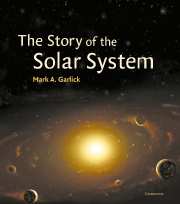Book contents
- Frontmatter
- Contents
- Miscellaneous Frontmatter
- Introduction
- Part 1 Genesis of the Sun and Solar Nebula
- Part 2 Emergence of the Sun's Family
- 2 200 000 years: Planetesimals and Protoplanets
- 2–3 million years: Gas Giants and Asteroids
- 3–10 million years: Ice Giants and Comets
- 3–10 million years: Regular Satellites
- 10–100 million years: Terrestrial Planets
- 100–1300 million years: The Heavy Bombardment
- 700–1300 million years: Building the Atmospheres
- 4500 million years? Formation of the Ring Systems
- 4660 million years: The Modern Solar System
- Part 3 Solar System Past and Present
- Part 4 End of an Era
- Glossary
- Index
100–1300 million years: The Heavy Bombardment
from Part 2 - Emergence of the Sun's Family
Published online by Cambridge University Press: 10 November 2009
- Frontmatter
- Contents
- Miscellaneous Frontmatter
- Introduction
- Part 1 Genesis of the Sun and Solar Nebula
- Part 2 Emergence of the Sun's Family
- 2 200 000 years: Planetesimals and Protoplanets
- 2–3 million years: Gas Giants and Asteroids
- 3–10 million years: Ice Giants and Comets
- 3–10 million years: Regular Satellites
- 10–100 million years: Terrestrial Planets
- 100–1300 million years: The Heavy Bombardment
- 700–1300 million years: Building the Atmospheres
- 4500 million years? Formation of the Ring Systems
- 4660 million years: The Modern Solar System
- Part 3 Solar System Past and Present
- Part 4 End of an Era
- Glossary
- Index
Summary
The planets had finally finished growing. Now they would begin their long process of evolution towards the way we see them today. By now, about 100 million years had passed and the Solar Nebula was relatively sparse. Yet its activity did not stop completely. For the Solar System was still littered with fragments of debris that had not yet been ejected from the system by the giants or been swept up by the terrestrials. It was at this point that the Solar System entered what astronomers call, quite justifiably, the heavy bombardment phase.
For hundreds of millions of years, leftover scraps continued to rain down on the planets and their satellites. This is the battering that shaped the planets' and moons' crusts, and the majority of it occurred in the first 600 million years or so of their creation. A glance at the surface of the Moon gives ample reminder of this violent phase in the Solar System's history. Many of the craters there are well over 100 kilometres across. One of them is about 12 kilometres deep and 2500 kilometres across – greater than half the Moon's diameter. Called the Aitken basin, it is the largest known impact structure in the entire Solar System, carved out when the Moon was struck a glancing blow from a piece of rock and metal some 200 kilometres across. This constant barrage meant that the crusts of the terrestrial planets and moons oscillated between molten and solid states for many hundreds of millions of years. The heaviest elements sank to their centres, while the lighter substances, buoyed up, stayed near the surfaces.
- Type
- Chapter
- Information
- The Story of the Solar System , pp. 36 - 37Publisher: Cambridge University PressPrint publication year: 2002



